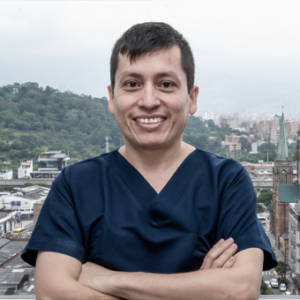Preparation for Colonoscopy
Hello, I am Mauricio González, your Gastroenterologist and the one who will perform the total Colonoscopy. I am going to give you recommendations so that you can prepare well for the colonoscopy.
The purpose of the preparation is to remove all the fecal matter from the colon so that it is clean and can be examined properly. In addition, good preparation makes the procedure easier and reduces the risks.

How is the preparation for Colonoscopy?
Buy a box of Travad Pik that comes with two sachets and a glass.
The day before the exam, fill the glass up to 150 ml, pour the contents of one sachet and mix it for two or three minutes until it is completely dissolved.
Take it at 7 at night. After this, drink at least 5 glasses of liquid (Water, clear juice in water, tea, aromatic, aguapanela, Clight, coffee, still soft drinks). Do it slowly and at your own pace
If your exam is between 7 and 9 in the morning, repeat the previous procedure with the second envelope and take it at 10 at night. Remember to drink at least 5 glasses of liquid afterwards (Slowly and calmly).
If the colonoscopy is after 9 in the morning, drink the second glass at 5 in the morning and drink 5 glasses of liquid between 5 and 7 in the morning.
The preparation does not taste bad, but you can help yourself by sucking on a candy, sandwich or panela. If you experience nausea or vomiting for a while and start taking it again very slowly and in small sips.
What can I eat before the Colonoscopy?
Three days before the exam, avoid eating foods that contain seeds (Granadilla, Pitaya, Watermelon 🍉, grapes 🍇).
The day before you can have breakfast and lunch as you normally do, but hopefully you will not consume grain foods such as beans, lentils, chickpeas, peas or corn.
At the end of the afternoon you can eat a light snack such as a sandwich or arepa with ham. 🥐
From then on, do not eat any more solid things, although you can drink all the liquids you want such as juices in water, aromatics, tea, coffee☕️, Gatorade, jelly
Other recommendations for Colonoscopy preparation
8 hour fast for solid foods:
Avoid eating solid foods 8 hours before the exam so that you do not have the risk of food residues going into the bronchi (Bronchoaspiration).
Bring an adult companion:
Due to sedation you may see some reflexes or your ability to concentrate diminished. That is why it is necessary to come with a person who is in charge of taking you home.
Therefore, it is not a good idea to come on a motorcycle or drive a car because this increases the risk of an accident.
Take your medications before the exam:
Before the procedure you can take your medications with a sip of water. If you are diabetic and take insulin, schedule the Colonoscopy as early as possible and apply it after the exam to reduce the risk of hypoglycemia.
Notify us about your health status:
If you have a delicate health condition or have had bad experiences during your exam or sedation, tell us so we can give you the appropriate recommendations or take the necessary measures.
You are not going to feel anything and here we are going to take care of you
We are all a little afraid of a new exam or when we have had bad experiences in the past. But our idea is that you are asleep, safe and without discomfort. After the exam, tell us how it went 👍.
In case of any inconvenience with your preparation for Colonoscopy, contact us by WhatsApp or call us at 📲3207571313.
I also invite you to learn more about us at https://endoscopiaycolonoscopia.com/en/
Greetings,

Mauricio González Hernández
Your Gastroenterologist in Medellín



